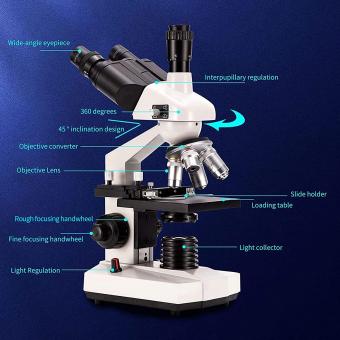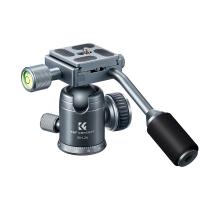What Is Mechanical Stage In Microscope ?
A mechanical stage in a microscope is a platform that holds the specimen slide and allows for precise movement of the slide in two dimensions. It typically consists of two knobs that control the movement of the slide in the x and y directions, allowing the user to easily navigate across the specimen and view different areas of interest. The mechanical stage is especially useful for examining larger specimens or for observing multiple areas of a single specimen, as it allows for accurate and repeatable positioning of the slide. Some mechanical stages also include a locking mechanism to hold the slide securely in place during observation. Overall, the mechanical stage is an important component of many microscopes, enabling precise and efficient examination of specimens.
1、 Definition of mechanical stage in microscopy

What is mechanical stage in microscope?
A mechanical stage in microscopy is a device that holds the specimen slide in place and allows for precise movement of the slide in two dimensions. It is an essential component of modern microscopes, particularly those used in research and clinical settings.
The mechanical stage typically consists of two knobs that control the movement of the slide in the x and y directions. These knobs allow the user to move the slide in a controlled and precise manner, making it easier to locate and examine specific areas of the specimen.
In addition to its precision, the mechanical stage also provides stability and security for the specimen slide. This is important because it prevents the slide from moving or shifting during observation, which could result in inaccurate or incomplete data.
Recent advancements in microscopy technology have led to the development of motorized mechanical stages, which allow for even greater precision and control. These stages can be programmed to move the slide automatically, making it easier to capture images and data from multiple areas of the specimen.
Overall, the mechanical stage is a critical component of modern microscopy, providing researchers and clinicians with the precision and control they need to accurately observe and analyze specimens.
2、 Components of a mechanical stage

What is mechanical stage in microscope?
A mechanical stage is a component of a microscope that allows for precise movement and positioning of the specimen being observed. It consists of a platform that holds the specimen and can be moved in two directions, typically using knobs or controls on the side of the microscope. The movement of the mechanical stage allows for the user to scan the entire specimen and focus on specific areas of interest.
Components of a mechanical stage:
1. Platform: The platform is the part of the mechanical stage that holds the specimen being observed. It is typically flat and can be adjusted to accommodate different sizes and shapes of specimens.
2. X-Y controls: The X-Y controls are knobs or controls on the side of the microscope that allow for precise movement of the mechanical stage in two directions. The X control moves the stage left and right, while the Y control moves it up and down.
3. Vernier scale: The vernier scale is a measurement tool that allows for precise positioning of the mechanical stage. It is typically located on the side of the microscope and can be used to measure the distance the stage has been moved.
4. Spring clips: Spring clips are used to hold the specimen in place on the mechanical stage. They are typically located on the sides of the platform and can be adjusted to hold specimens of different sizes.
5. Stage lock: The stage lock is a mechanism that locks the mechanical stage in place once the specimen has been positioned. This prevents the stage from moving during observation and ensures that the specimen remains in focus.
In recent years, some microscopes have been developed with motorized mechanical stages that allow for even more precise movement and positioning of the specimen. These motorized stages can be controlled using a computer or other electronic device, making it easier to scan large specimens or observe multiple areas of interest.
3、 Types of mechanical stages

What is mechanical stage in microscope?
A mechanical stage is a device that is used in microscopes to hold and move the specimen being observed. It is a platform that can be moved in two directions, allowing the user to position the specimen under the microscope's objective lens. The mechanical stage is typically controlled by two knobs, one for moving the stage horizontally and the other for moving it vertically.
There are different types of mechanical stages available for microscopes, including manual and motorized stages. Manual stages require the user to physically move the stage using the knobs, while motorized stages are controlled by a computer or other electronic device.
The mechanical stage is an important component of a microscope, as it allows for precise positioning of the specimen being observed. This is particularly important when studying small or delicate specimens, as even slight movements can cause the specimen to become out of focus or damaged.
In recent years, there has been a trend towards the development of more advanced mechanical stages that offer greater precision and control. These stages may include features such as automated positioning, programmable movements, and advanced imaging capabilities. As technology continues to advance, it is likely that we will see even more sophisticated mechanical stages being developed for use in microscopy.
4、 Advantages of using a mechanical stage

What is mechanical stage in microscope?
A mechanical stage is a device that is used in a microscope to hold and move the specimen being observed. It consists of a platform that can be moved in two directions, usually with the help of knobs or controls, allowing for precise positioning of the specimen under the microscope's objective lens.
Advantages of using a mechanical stage:
1. Precise positioning: The mechanical stage allows for precise positioning of the specimen, which is important for accurate observation and analysis.
2. Consistency: The use of a mechanical stage ensures that the specimen is always in the same position, which is important for consistency in observations and measurements.
3. Efficiency: The use of a mechanical stage can save time and increase efficiency, as it allows for quick and easy movement of the specimen without having to constantly adjust its position manually.
4. Reduced risk of damage: The mechanical stage reduces the risk of damage to the specimen, as it allows for smooth and controlled movement without the need for excessive handling.
5. Improved ergonomics: The use of a mechanical stage can improve ergonomics, as it reduces the need for repetitive manual movements that can cause strain and fatigue.
In the latest point of view, the use of a mechanical stage has become even more important with the increasing use of digital microscopy and image analysis. Precise positioning of the specimen is essential for accurate digital imaging and analysis, and the use of a mechanical stage can help ensure that the same area of the specimen is always in focus and properly aligned. Additionally, some modern microscopes now come equipped with motorized mechanical stages, which further increase efficiency and precision in specimen positioning.





































